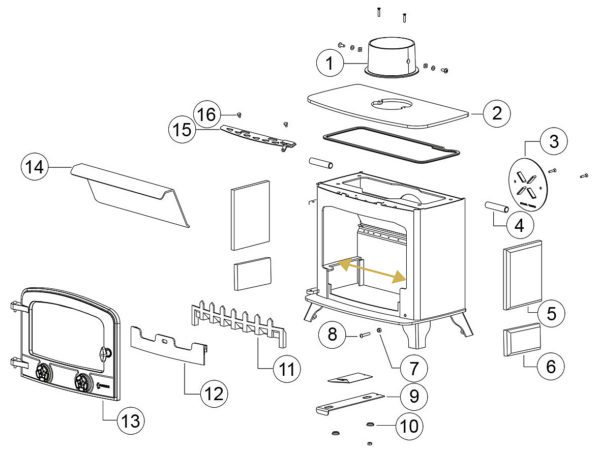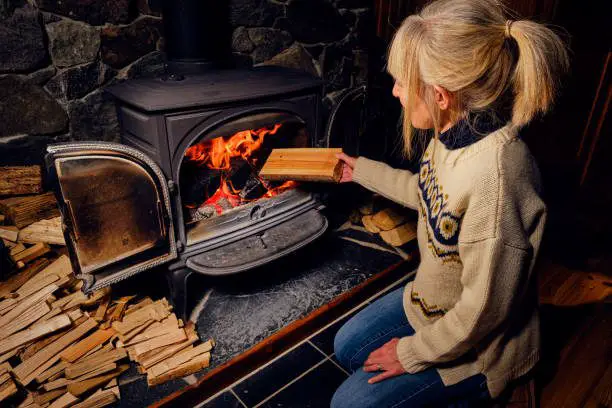Are you considering adding a wood stove to your home but feel overwhelmed by the different parts of a wood stove and terminology involved? Look no further! This essential guide will help you understand the various components of a wood stove, allowing you to make an informed decision and enjoy the cozy warmth it brings.
From the firebox, door, and baffle to the flue, damper, and ash pan, each part plays a crucial role in how a wood stove operates. By familiarizing yourself with these components, you’ll have a better understanding of how to safely operate, maintain, and troubleshoot your wood stove.
Not only will this guide provide you with the knowledge you need to make the most of your wood stove, but it will also empower you to choose the right stove for your specific needs and preferences. So whether you’re interested in the aesthetics, efficiency, or heat output of a wood stove, this guide will be your go-to resource.
Get ready to embark on a journey of wood stove mastery. Let’s delve into the different parts of a wood stove and unlock the secrets of cozy warmth.
Wood burning stove parts diagram

1. Flue Collar: Connects the appliance to the flue system and is typically secured with screws or a twist lock arrangement.
3. Blanking Plate (or cover plate/hotplate): Covers the unused flue exit.
4. This item is exclusive the Yeoman range. Its an extension tube for the baffle to rest on. Unlikely to see this unless you have a Yeoman Stove.
5 & 6. Firebricks or Liners: These line the interior of the stove, providing protection to the appliance body and reflecting heat back into the stove for improved efficiency.
Primary Air Controls: Controls for regulating the primary airflow in the stove.
7, 8, 9, 10. Numbers indicating the primary air controls.
11 & 12. Front Fuel Retainers or Log Guards: Prevents fuel from falling out of the stove.
13. Main Fire Door: Equipped with a glass, gasket seal, and fixings. The door includes a rope seal for airtight closure.
14. Baffle or Throat Plate: A common stove part, preventing flames from entering the flue, creating a natural draw, and pushing heat to the front of the stove.
15 & 16. Secondary Air Controls: Controls for managing secondary airflow in the stove.
Yellow Arrow: Depicts a woodburner; for a Multi Fuel stove, there would be a grate arrangement similar to the arrow. An ashpan would be present underneath to collect ash, and an additional ash door might be located on the exterior. Note: Exclusive to the Yeoman range is an extension tube for the baffle (item 4), visible only in Yeoman Stoves.
Understanding the different parts of a wood stove
Wood stoves have been a popular choice for heating homes for centuries. Understanding the different parts of a wood stove is essential for maximizing its performance and ensuring your safety. Let’s explore the key components that make up a wood stove.
The firebox: where the magic happens
The firebox is the heart of the wood stove. It is where the wood is burned to produce heat. Made of fire-resistant materials such as cast iron or steel, the firebox is designed to withstand high temperatures and contain the combustion process. It is important to choose a wood stove with a spacious firebox that can accommodate the size of logs you plan to burn.
The firebox typically has a door that allows you to load wood into it. The door should have a tight seal to prevent smoke from escaping into your home. Some wood stoves also feature a glass window on the door, allowing you to enjoy the mesmerizing sight of the flames while keeping the door closed.
The flue: directing smoke and gases
The flue is a pipe that connects the wood stove to the chimney. Its primary function is to direct smoke and gases produced during combustion out of your home. A well-designed flue ensures proper ventilation and prevents smoke from entering your living space.
Flues are usually made of stainless steel or heat-resistant ceramic material. They come in different shapes and sizes, depending on the type of wood stove and the layout of your home. It is crucial to install the flue correctly, ensuring it is properly insulated and free from any obstructions that could impede the flow of smoke.
The damper: controlling airflow
The damper is a device that controls the airflow inside the wood stove. It is usually located in the flue or the stovepipe. By adjusting the damper, you can regulate the amount of air that enters the firebox, thus controlling the intensity of the fire.
A closed damper restricts airflow, resulting in a slower burn and less heat output. On the other hand, an open damper allows more air into the firebox, creating a hotter fire. It is important to find the right balance when operating the damper to achieve optimal heat efficiency and burn time.
The baffle: maximizing heat efficiency
The baffle is a plate or series of plates located inside the wood stove, above the firebox. Its purpose is to maximize heat efficiency by directing the flow of hot gases and smoke. The baffle helps extract as much heat as possible from the combustion process before they exit through the flue.
Baffles are typically made of cast iron or steel and are designed to withstand high temperatures. They are strategically positioned to create a longer and more efficient path for the gases and smoke to travel. A well-designed baffle system can significantly increase the heat output and reduce fuel consumption.
The ash pan: easy cleaning and maintenance
The ash pan is a removable tray or drawer located at the bottom of the wood stove. It collects the ashes and debris generated during the burning process. Having an ash pan makes cleaning and maintenance of the wood stove much easier and more convenient.
To clean the ash pan, simply remove it from the stove, empty the ashes into a designated container, and dispose of them properly. Regular cleaning of the ash pan prevents the buildup of ash, which can impede airflow and reduce the efficiency of the wood stove.
The door and glass: aesthetic and functional features
The door of a wood stove serves both aesthetic and functional purposes. It provides access to the firebox for loading wood and ensures a tight seal to prevent smoke from escaping into your home. The door should be made of durable materials and have a reliable locking mechanism for safety.
Some wood stoves come with a glass window on the door, allowing you to enjoy the beauty of the flames while keeping the door closed. The glass should be made of high-temperature resistant material and designed to stay clear, providing an unobstructed view of the fire. Regular cleaning of the glass is necessary to remove any soot or residue that may accumulate.
The stovepipe: connecting the stove to the chimney
The stovepipe is a pipe that connects the wood stove to the flue or chimney. It carries the smoke and gases from the wood stove to the outside. The stovepipe should be properly installed, insulated, and sealed to ensure a secure connection and prevent leaks.
Stovepipes are available in different materials, such as stainless steel or black-coated steel. It is important to choose a stovepipe that is compatible with your wood stove and meets local building codes and regulations. Regular inspection and maintenance of the stovepipe are necessary to ensure its integrity and prevent potential hazards.

The ash pan: easy cleaning and maintenance
The ash pan is a convenient feature found in many modern wood stoves, making the cleaning and maintenance process a breeze. It is a removable tray located beneath the firebox that collects the ash and debris produced during combustion. By regularly emptying the ash pan, you can prevent excessive ash buildup and maintain optimal stove performance.
To clean the ash pan, simply remove it from the stove and dispose of the ashes in a safe manner. Some wood stoves have an integrated handle or a mechanism that allows you to easily dump the ashes without coming into direct contact with them. It is important to wait until the ashes have completely cooled before disposing of them to avoid the risk of fire.
Regularly cleaning the ash pan not only keeps your wood stove functioning efficiently but also prevents the accumulation of ash that can hinder airflow and affect combustion. It is recommended to clean the ash pan after each use or at least once a week, depending on the frequency of stove operation. By incorporating ash pan maintenance into your routine, you can enjoy hassle-free wood stove ownership.
In this comprehensive guide about wood burning stove parts diagram, readers are introduced to the intricacies of wood stoves, breaking down each essential component for a better understanding. The article emphasizes the significance of familiarizing oneself with parts like the firebox, flue, damper, baffle, ash pan, door, glass, and stovepipe to ensure safe and efficient operation.
The heart of the wood stove is the firebox, constructed with fire-resistant materials and featuring a door with a tight seal. The flue, connecting the stove to the chimney, plays a crucial role in directing smoke outside, while proper installation is stressed for ventilation and safety. The damper regulates airflow, impacting fire intensity and heat output, emphasizing the need to find the right balance.
The baffle, strategically positioned above the firebox, enhances heat efficiency by directing hot gases. Made of durable materials, it ensures optimal heat extraction before gases exit through the flue. The ash pan, located at the stove’s bottom, facilitates easy cleaning and maintenance by collecting ashes and debris, emphasizing the importance of regular cleaning to prevent airflow issues.
The article also highlights the door’s dual purpose, providing access to the firebox and serving as a seal against smoke. Some wood stoves feature glass windows for aesthetic appeal, emphasizing the need for high-temperature resistant glass and regular cleaning. The stovepipe, connecting the stove to the chimney, must be properly installed and maintained to prevent leaks and ensure safety.
The guide concludes by underscoring the convenience of ash pans in modern wood stoves, emphasizing their role in facilitating cleaning and maintenance. Regular emptying of the ash pan is recommended to prevent ash buildup, ensuring optimal stove performance and hassle-free ownership. Overall, the guide empowers readers to make informed decisions regarding wood stoves, whether driven by aesthetics, efficiency, or heat output.

